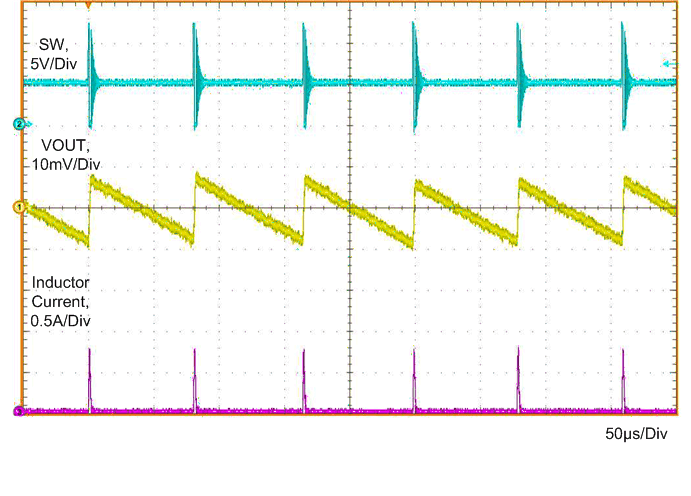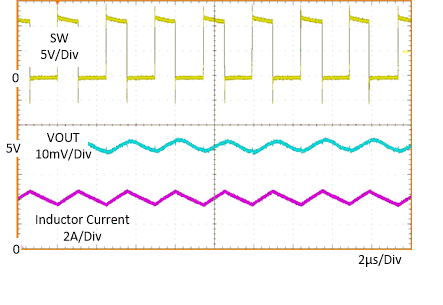SNVSB99C October 2019 – November 2020 LMR33640
PRODUCTION DATA
- 1 Features
- 2 Applications
- 3 Description
- 4 Revision History
- 5 Device Comparison Table
- 6 Pin Configuration and Functions
- 7 Specifications
- 8 Detailed Description
- 9 Application and Implementation
- 10Power Supply Recommendations
- 11Layout
- 12Device and Documentation Support
- 13Mechanical, Packaging, and Orderable Information
Package Options
Mechanical Data (Package|Pins)
- DDA|8
Thermal pad, mechanical data (Package|Pins)
- DDA|8
Orderable Information
8.4.1 Auto Mode
In auto mode, the device moves between PWM and PFM as the load changes. At light loads, the regulator operates in PFM. At higher loads, the mode changes to PWM. The load current for which the device moves from PFM to PWM can be found in Section 9.2.3. The output current at which the device changes modes depends on the input voltage, inductor value, and the output voltage. For output currents above the curve, the device is in PWM mode. For currents below the curve, the device is in PFM. The curves apply for a nominal switching frequency of 400 kHz and the BOM shown in Table 9-3. For applications where the switching frequency must be known for a given condition, the transition between PFM and PWM must be carefully tested before the design is finalized.
In PWM mode, the regulator operates as a constant frequency converter using PWM to regulate the output voltage. While operating in this mode, the output voltage is regulated by switching at a constant frequency and modulating the duty cycle to control the power to the load. This provides excellent line and load regulation and low-output voltage ripple.
In PFM, the high-side MOSFET is turned on in a burst of one or more pulses to provide energy to the load. The duration of the burst depends on how long it takes the inductor current to reach IPEAK-MIN. The periodicity of these bursts is adjusted to regulate the output, while diode emulation (DEM) is used to maximize efficiency (see the Glossary). This mode provides high light-load efficiency by reducing the amount of input supply current required to regulate the output voltage at light loads. PFM results in very good light-load efficiency, but also yields larger output voltage ripple and variable switching frequency. Also, a small increase in output voltage occurs at light loads. The actual switching frequency and output voltage ripple depend on the input voltage, output voltage, and load. Figure 8-8 and Figure 8-9 show typical switching waveforms in PFM and PWM. See Section 9.2.3 for output voltage variation with load in auto mode.
 Figure 8-8 Typical PFM Switching Waveforms VIN =
12 V, VOUT = 5 V, IOUT = 10
mA
Figure 8-8 Typical PFM Switching Waveforms VIN =
12 V, VOUT = 5 V, IOUT = 10
mA Figure 8-9 Typical PWM Switching Waveforms VIN =
12 V, VOUT = 5 V, IOUT = 4
A, ƒS = 400 kHz
Figure 8-9 Typical PWM Switching Waveforms VIN =
12 V, VOUT = 5 V, IOUT = 4
A, ƒS = 400 kHz